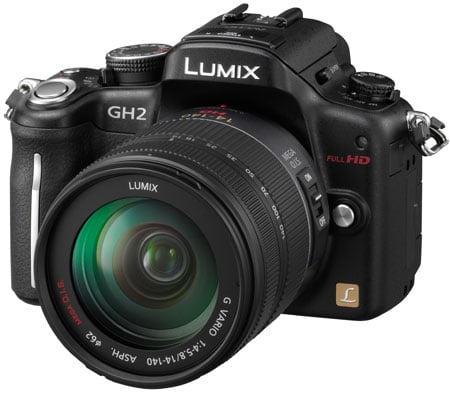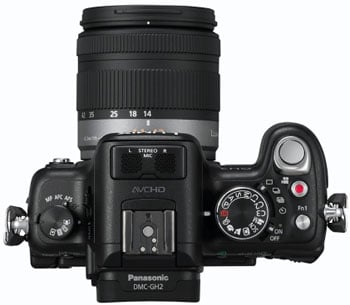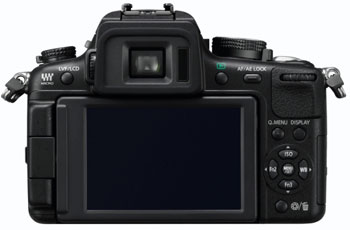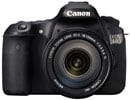Panasonic Lumix DMC-GH2
-
-
Written by Gordon Laing
Verdict
Panasonic’s Lumix DMC-GH2 is one of the most successful hybrid cameras we’ve tested at Camera Labs. It confidently captures both high quality stills and HD video with the minimum of fuss or compromise, while also boasting a number of capabilities that take it beyond most rivals. If you want a single camera which does photos very well and movies even better, the Lumix GH2 should be high on your shortlist.
Panasonic has taken the already capable Lumix GH1, increased its sensor resolution by one third, accelerated the focusing both for stills and movies, added a touch-screen display, widened the electronic viewfinder, sped-up continuous shooting, and enhanced the movie recording options. The upgrades add up to an impressive experience which crucially is more affordable than its predecessor thanks to a new cheaper lens bundle or a body-only option in addition to the original 14-140mm kit. Let’s look at each upgrade in turn.
Starting with the sensor, it’s inevitable to find Panasonic increasing the resolution on the GH2, although given all previous Micro Four Thirds bodies stuck with 12 Megapixels, the boost to 16 Megapixels in the same surface area (when capturing 4:3 images) understandably gives cause for concern. But the GH2’s sensor defies expectations by actually delivering lower noise levels than the 12 Megapixel sensor in the Lumix GF2, while also beating it on resolving power. It’s not perfect: in our tests we found it gradually becoming less sensitive at high ISOs than the quoted values suggested, but it’s still the best result we’ve had from a Micro Four Thirds body to date, while also proving the format can successfully scale beyond 12 Megapixels without compromise. Shooting in RAW delivers particularly good results.
 |
Moving onto autofocus, Panasonic is clearly on a very welcome mission to prove contrast-based AF can be as quick or even quicker than the phase-change AF systems on traditional DSLRs. As a body based on the Micro Four Thirds standard, the Lumix GH2 is a mirrorless camera which employs Live View for all composition, and as such relies on contrast-based autofocus. DSLRs which employ contrast-based AF during Live View have typically been fairly leisurely, giving the technology a bad name, but with the earlier Lumix GH1, Panasonic managed not only to beat them on speed, but also match or even surpass their traditionally quicker phase-change systems – at least on budget DSLRs anyway.
 | |
 | |
Most people would still be happy with the GH1’s AF speed, but Panasonic’s impressively doubled it on the GH2, making it as quick as the phase-change AF systems on most mid-range or even semi-pro DSLRs. In use it feels incredibly quick, especially with the 14-140mm super-zoom lens, although it’s still very swift on the cheaper 14-42mm kit. As importantly though, a contrast-based AF system takes readings from the same sensor which records your photos, so avoids potential front or rear focusing errors which plague separate phase-change sensors. So the GH2 enjoys the best of both worlds: the accuracy of a contrast-based system with the speed of phase-change. It’s also refreshing to find the Panasonic lenses focusing in virtual silence, especially the 14-140mm.
Moving onto the movie capabilities, you’d think Panasonic didn’t have much room for improvement when the earlier Lumix GH1 already offered Full HD 1080i resolution with continuous autofocus and the choice of manual exposure control, but the GH2 makes a number of very welcome improvements. Most importantly, the continuous autofocus is now faster than before when recording 1080i footage. Previously the GH1’s sensor outputted 24fps for NTSC regions or 25fps for PAL regions, then scaled it to 60i or 50i respectively when encoding the video. Now the GH2’s sensor outputs 60fps for NTSC and 50fps for PAL regions, which is encoded at 60i or 50i respectively. The faster frame rates outputted by the new sensor allow the camera to make quicker and smoother AF adjustments.
It’s born-out in practice too. The GH2’s 1080i video mode does a great job at continuous autofocusing, successfully tracking subjects or pulling focus between subjects at different distances. There’s a small amount of searching on the latter as it confirms the position, but it’s as good as the continuous AF on most camcorders we’ve tested (and as quiet too with the 14-140mm), which is all many potential buyers will need to know.Â
Other welcome enhancements include a new 1080 24p mode, adjustable audio recording levels (complete with live on-screen meters), a neat tele-converter option which crops an HD frame from the middle of the sensor (rather than binning pixels across the entire frame) to deliver 2.6x or 3.9x magnification in 1080 and 720 modes, and a clean 1080i output from the HDMI port for an external monitor, even while recording video. The new 80-300% variable speed options were less useful in our view, but the rest adds up to one of the best movie experiences on a non-camcorder to date.
Physically the Lumix GH2 very much resembles its predecessor with the only major change being a new touch-screen panel. At first, non-believers will groan at its presence and be relieved Panasonic still includes a full array of physical buttons and dials if preferred, but it really does offer some very useful functions. The most compelling in our opinion is the ability to automatically pull-focus between subjects while filming by simply tapping them on-screen. No need to recompose the shot or manually adjust the focusing ring – you just point at the desired subject and the camera will smoothly refocus on it. Great for scenes with dialogue between two people. Again there’s a little searching with each refocus, but it’s quick and fairly discreet, thereby opening-up new creative opportunities for amateur film makers who don’t want to manually adjust the focusing while filming.
Panasonic has also widened the Live View Finder to deliver a 3:2 aspect ratio which is a better fit for a camera which could find itself shooting 4:3, 3:2 or 16:9 material. Those with sensitive eyes may still notice a small amount of rainbow tearing when quickly glancing across the viewfinder image, but it remains superior to most other electronic viewfinders we’ve tested.
So far a glowing report, but there are of course some downsides to the Lumix GH2. While Panasonic has provided a welcome boost to the continuous shooting speed, which now offers up to 5fps at the full resolution, the Lumix GH2 is not the best camera for capturing action stills. The problem facing it – and most 100% Live View systems – is the inability to show a live image in-between frames, which makes it hard to follow the action.
This is something we take for granted with a DSLR, where for a split second between continuous frames the optical viewfinder lets you see exactly where the action has moved onto, allowing you to follow it at the right speed and keep it in the frame. In contrast, most cameras which rely on Live View for composition only have time to show you a preview of the last photo between frames, which forces you to guess how much to move the camera. This is slightly delayed feedback as opposed to a real-time view, and if your subject is moving quickly or unpredictably, it’s easy to lose it.
The Lumix GH2 is sufficiently quick to offer a live image when shooting at 2 or 3fps, but switch it to 5fps, or the new 40fps mode at 4 Megapixels, and you’ll be left guessing with only preview images to guide you. In our tests we also found the GH2 slowing to around 2fps when continuous AF was enabled, meaning you might as well just select the 2fps mode in the first place and at least enjoy the benefit of live view between frames.
Sticking on the subject of optical versus electronic composition, there are pros and cons to both approaches. The GH2’s Live View finder is one of the best around, delivering a larger image than most DSLR viewfinders, while also supporting super-imposed colour graphics. But like all electronic viewfinders to date it has a limited dynamic range which means bright highlight areas can appear as areas of pure white, while in dim conditions, the image can become noisy and suffer from reduced frame rates. As mentioned earlier and in the main review, there can also be visible rainbow tearing when glancing quickly around the image, and undesirable artefacts when panning across fine lines. Shooting with an optical viewfinder also greatly extends your battery life.
The bottom line is action and low-light shooters will prefer traditional optical viewfinders, and if any of the above sounds like a potential issue for you personally, we’d strongly recommend trying a camera with an electronic viewfinder before buying. To be fair, these criticisms apply to all electronic viewfinders, and while the GH2 has one of the best around, it’s still worth knowing.
Now before our final verdict, how does it measure-up against the competition?
Compared to Sony Alpha SLT-A33 / A55
|
Sony’s ‘Single Lens Translucent mirror’ cameras, or SLTs for short, are arguably the biggest rivals to the Lumix GH2, as each are hybrid models designed to deliver decent stills and HD video without the compromises of traditional DSLRs.
While both the SLTs and GH2 employ 100% Live View from their main sensors though, their approach to autofocusing is entirely different. The Lumix GH2 employs a mirrorless optical path with a fast contrast-based system taking AF readings from the main sensor. The Sony SLTs employ a fixed translucent mirror in the optical path which diverts some of the light to a traditional phase-change AF sensor, which unlike a DSLR, can remain active even while photos or video are being recorded by the main sensor.
Each approach supports quick and continuous autofocus while filming video, although there’s pros and cons to both systems. In our tests we found the Sony SLT cameras generally locked-onto subjects with minimal or even no visible searching back and forth, but the motors on the kit lenses were quite audible while doing so. In comparison, the Lumix GH2 visibly searched a little more, but its lenses – including the cheapest 14-42mm kit zoom – did so almost silently. Tipping the decision a little in the GH2’s favour was its touch-screen which allowed easy focus-pulling between subjects while filming by simply tapping on them. The bottom line though is both the SLT cameras and the Lumix GH2 delivered far superior continuous autofocusing to a traditional DSLR while filming.
In terms of AF for still photos, the Lumix GH2 was noticeably quicker and quieter than the Sony SLTs, and since it was using data from the main sensor, it also avoided any front and rear focusing errors – which we did notice from time to time on our Sony A33 sample.
But quicker AF for still photos doesn’t necessarily make the GH2 the preferable camera for action. With continuous AF enabled, we found it struggled to deliver more than 2fps, while the Sony A33 managed just under 6fps under the same real-life conditions. Switch off continuous AF and the Sony A55 will go even faster. This makes the Sony SLTs much better for fast action, although both them and the GH2 suffered from a lack of real-time feedback in-between frames when shooting continuously. This really rules them all out for effective action photography where the subject pans quickly or moves unpredictably.
As 100% live view cameras, the quality of the screen and electronic viewfinder are critical, and again there’s pros and cons to each camera. Panasonic has opted for 3:2 shaped panels for both the GH2’s screen and finder which are a good compromise for images which could be 4:3, 3:2 or 16:9 in shape. In contrast, Sony has opted for 16:9 panels, which are obviously preferable when shooting 16:9 content, but deliver smaller image areas in 3:2. It’s also worth noting the GH2 and SLT viewfinders are roughly the same width, so when shooting 16:9 content, the image is displayed at roughly the same size on both cameras; so the Sony only has a size advantage when shooting 16:9 on its main screen.
We also found the GH2’s Live View finder suffered from less rainbow tearing than the Sony SLTs, although this can vary from person to person, and in some consolation, the Sony’s main screen is higher resolution. Then there’s the touch-screen aspect of the GH2, which some may not be bothered by, but others will love; certainly being able to pull-focus while filming by tapping on the desired subject is a neat trick. The final comment on the screens regard their articulated mountings: both can flip and twist to any angle, but we found the hinge at the bottom of the Sony less convenient and intuitive than the one on the side of the GH2; for example, the Sony screen could be blocked when mounted on a tripod.
In terms of size and weight, the Sony SLTs may be more compact than a typical DSLR, but the GH2 comes in a little smaller and lighter with a similar kit lens, without compromising ergonomics.
At the time of writing, we hadn’t formally tested the A55’s image quality, so can only comment on how the cheaper A33 compared to the GH2. In our tests the A33 delivered very good results, although was unsurprisingly out-resolved by the GH2 as you’d expect when comparing 12 Megapixels against 16. In low light at higher ISOs, you’d expect the bigger APS-C sensor of the A33 to easily outperform the GH2, but the light loss of Sony’s translucent mirror coupled with a surprisingly low noise sensor in the Panasonic, make them a reasonably close match. Indeed at higher ISOs, the output from the GH2 was often preferred, but as seen in our results pages, it worryingly becomes darker with each ISO increment, suggesting a reduction in actual sensitivity.
We should also mention the additional shooting modes of the Sony’s which capture and combine multiple frames to reduce noise – which they do very effectively. In addition the Sony’s feature automatic panorama generation, in-camera 3D capture (without the need for a separate lens), in-camera HDR, and in the case of the A55, a built-in GPS. Both the Sony SLTs also boast in-camera stabilisation which works with any lens you attach.
The Lumix GH2 is however the more sophisticated movie camera, sporting additional 1080 / 24p and variable speed modes, clean 1080i HDMI output even when filming, adjustable audio levels, a tele-converter which doesn’t compromise resolution, and full manual control over exposures.
There’s so much to compare and contrast it’s almost impossible to recommend one over the other, but having used the GH2 and A33 extensively side by side, it becomes clear the former feels more sophisticated, especially in terms of movies and displays. But the Sony’s take the lead on continuous shooting and their array of innovative shooting modes, not to mention comfortably lower prices. The higher-end A55 boasts GPS and 10fps shooting, yet costs 15% less than the GH2 in a similar kit, while the A33 kit comes across as a bargain at 25-30% cheaper. Independent film makers will justify the higher cost of the GH2, but anyone else looking at a hybrid camera will find the Sony SLTs hard to beat for the money.
See our Sony Alpha SLT-A33 review for more details. Note this should be completed during February.
Compared to Canon EOS 60D
It’s worth comparing a traditional DSLR against the Lumix GH2, and one of the most popular mid-range models with video as a priority is the Canon EOS 60D. Both the EOS 60D and GH2 shoot high resolution stills, Full HD video and sport fully articulated screens. There are of course considerable differences to weigh-up though.
Most obviously the EOS 60D is a much heftier camera, with a body that’s 21mm wider, 16mm taller and 3mm thicker (including protrusions), not to mention considerably heavier at 755g compared to 444g. The Lumix GH2 is simply much more portable, although many traditionalists will find the relative heft of the EOS 60D more reassuring in their hands.
Both cameras feature 3in screens with 3:2 aspect ratios which are articulated from the side. The EOS 60D’s display features a much higher resolution of 1040k dots compared to 460k on the GH2, but countering that are the touch-screen capabilities of the Panasonic. While the extra resolution is nice to have on the Canon, the touch-screen of the Panasonic gives it genuine functional benefits such as tapping to pull-focus between different subjects while filming.
As a traditional DSLR, the EOS 60D employs an optical viewfinder, whereas the Lumix GH2 has an electronic ‘Live View Finder’. Both have their pros and cons. An optical viewfinder is easier to use in low light or when following action, and also lets you ‘see’ a broader dynamic range of tones; it additionally allows the battery to last much longer, typically capturing three to four times more shots than in Live View alone. In contrast, the GH2’s Live View Finder delivers a slightly larger image which can enjoy super-imposed colour graphics and guides, such as live histograms or different alignment grids. Which is better is entirely personal and dependant on the kind of photos you take.
Staying on the subject of action though, the EOS 60D is much better equipped to handle it for stills than the Panasonic. The EOS 60D not only has an optical viewfinder which makes following action much easier, but could maintain rates of over 5fps with continuous AF compared to around 2fps on the GH2 in our tests. If you’re into action photography, it’s an easy win for the EOS 60D over the GH2.
Interestingly an area where you’d expect the EOS 60D to beat the GH2 is autofocusing speed, but the lightening-fast contrast-based system on the GH2 is as quick as the phase-change system on the EOS 60D and much faster than its contrast-based alternative in Live View. So the GH2 enjoys the benefits of a contrast based AF system such as face detection and lack of front and rear focusing errors, but with the speed of a decent phase-change system. We’d say this gives the GH2 the edge over the EOS 60D
In terms of still photo quality, the EOS 60D out-performs the GH2. You won’t notice much difference in real-life detail at low ISOs, but at very high sensitivities, the larger APS-C sensor of the Canon simply gathers more light and delivers cleaner results. But if you shoot at 800 ISO or below, the difference may be less than you think.
Things are much closer when it comes to movie quality though, with both cameras offering Full HD video at a variety of frame rates including 24p, and full manual control over exposures. Where the GH2 takes the lead though is in terms of autofocusing while filming. The EOS 60D can take several seconds to refocus while filming, whereas the GH2 will do it in an instant – and much more quietly too. If you want continuous autofocus while filming like a camcorder, there’s no competition. The Lumix GH2 also takes Canon’s Movie Crop function and runs with it, offering tele-converter options for 720p or 1080i modes rather than just VGA. It additionally offers a clean 1080i output over HDMI during filming for external monitors as opposed to the standard definition output of the 60D’s HDMI port once you press record.
It’s not all one-sided: while both cameras offer mic inputs and manual recording levels, the EOS 60D features a standard 3.5mm jack, finer audio levels and bigger meters, albeit not visible while filming. But this doesn’t make up for the other benefits of the GH2’s movie mode, which is ultimately preferred.
In terms of price, the body and basic lens kits are roughly the same, so it boils down to comparing features and handling. If video is your priority and you want continuous AF, not to mention a more portable body, then the GH2 is the preferred choice. But if stills are your priority, especially during action sequences or in low light, then the 60D delivers a superior experience.
See our Canon EOS 60D review for more details.
Panasonic Lumix DMC-GH2 final verdict
The Panasonic Lumix DMC-GH2 delivers one of the most satisfying and uncompromised experiences from a hybrid camera to date. Still photo quality is as the best we’ve seen from the Micro Four Thirds standard and keeps-up with APS-C sensors at low to mid sensitivities even with its boost in resolution, while autofocus is very snappy, proving contrast-based systems can actually out-perform phase-change systems while avoiding potential front and rear focusing errors.
The video is the real highlight though, with the GH2 sporting Full HD capture with 24p and variable speed options, genuine continuous autofocus, manual exposure control, and very neat touch-screen focusing which lets you pull-focus between subjects without changing the composition or turning a manual focusing ring. And thanks to the design of the lenses, the autofocusing is quiet too. The absence of a motorised zoom aside, the movie experience is as usable as a modern camcorder, but with the benefit of a big sensor and interchangeable lenses.
Like all hybrid cameras, you’ll find areas where a more specialised model will out-perform it. The 100% Live View system isn’t suited to following fast or unpredictable action, and the continuous shooting speed is slow when coupled with continuous AF. In very low light, the electronic viewfinder becomes slower and noisy, and at high sensitivities, a good APS-C camera will deliver cleaner results. The bottom line is if you’re into action or low light photography, you’ll find a traditional DSLR preferable.
But for stills under general conditions, the GH2 performs very well with clean, detailed images and the benefit of the ultra-fast AF system mentioned earlier. And again the movie capabilities are some of the best we’ve tested to date.
If you want a camera that’s good for day-to-day stills and excellent for video, the GH2 is therefore an ideal choice, but you should also compare it closely with its big hybrid rivals from Sony, the Alpha SLT A33 and A55. Each delivers faster continuous shooting, built-in stabilisation, an array of clever shooting modes, and in the case of the A55, built in GPS, all at a comfortably lower price point. But again in our side-by-side tests, the Lumix GH2 delivered a more sophisticated experience, especially for movies. So if video is your priority in a hybrid camera, it’s worth spending the extra on the Lumix GH2 – it easily earns our Highly Recommended rating as one of the most successful hybrid cameras we’ve tested, and one that’s a joy to use.








